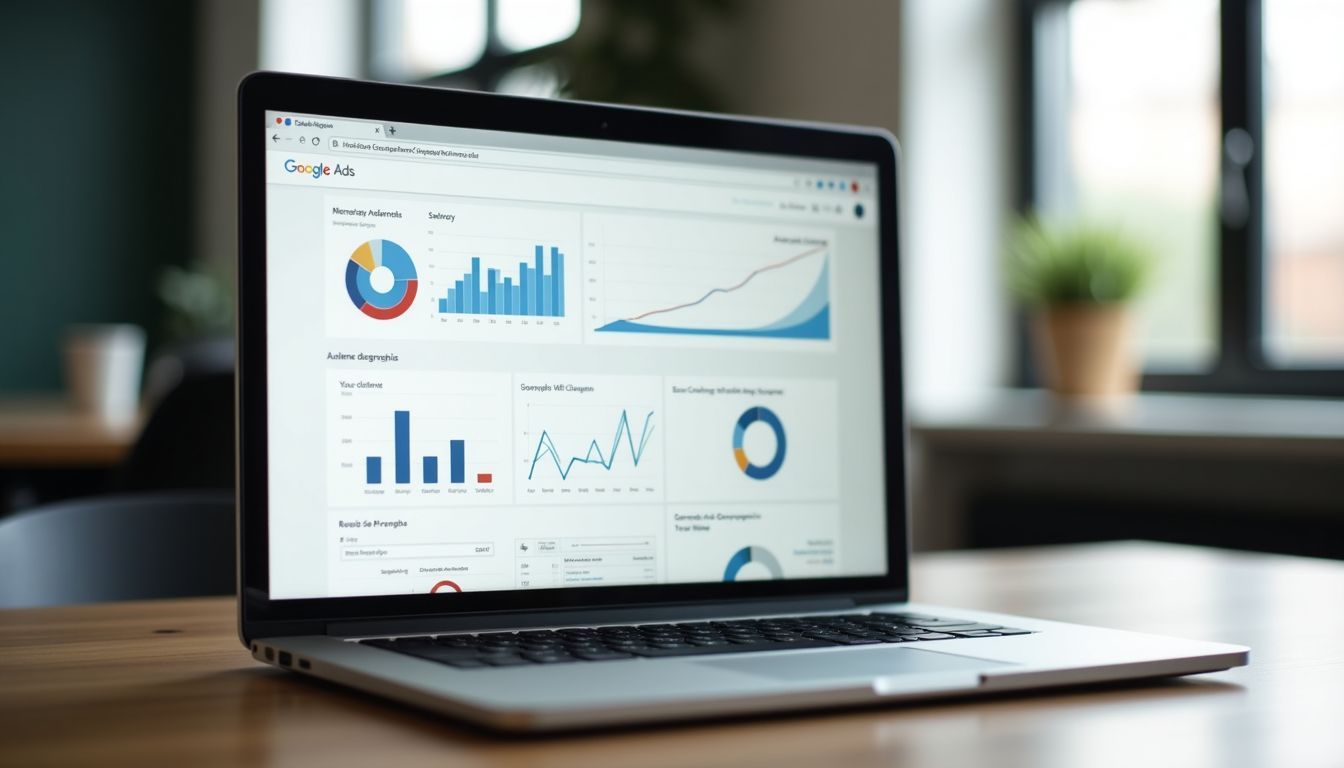Are you struggling to get more sales through online ads? Google Ads can be a powerful tool for boosting your business. This article will show you how to use Google Ads to increase your return on investment (ROI).
Important Points
- Start by picking the right type of Google Ad campaign and setting a smart budget. This helps make sure you don’t spend too much or too little.
- Use Google AI to target your ads better. It finds the right people who might buy what you’re selling. Performance Max campaigns can also show your ads on more platforms like YouTube and Google search.
- Make your ads work well on mobile phones because many people use their phones to look up stuff online.
- Keep testing your ads with A/B testing to see which ones do best. Also, track how they’re doing with tools like Google Analytics.
- Focus on making clear and attractive visuals for your ads, especially if they will be shown as display or video ads, to grab more attention.
Setting Up Your Google Ads Account

Starting your Google Ads journey means setting up an account first. Pick the right type of campaign and set your budgets and bids with care.
Table of Contents
Choosing the Right Campaign Type
Picking the right campaign type needs a match between your goal and the ad options Google offers. If you want more visitors to your store, consider search ads that show up in Google results when someone looks for what you offer.
For online sales goals, shopping ads put your products upfront. Videos on YouTube can help spread the word about your brand far and wide.
Google’s Performance Max campaigns use smart tech to find the best places for your ads across all their platforms — from videos to display networks. This means you don’t have to guess where your ad might work best; Google AI does that heavy lifting.
Matching your business aim with the correct type of ad is key to getting real results like more sales or leads.
Setting Budgets and Bids Strategically
After you choose the right campaign type, think about your budget and bids. This step is key for success in Google Ads. You don’t want to spend too much or too little. The average cost per click (CPC) in the U.S. is $2.32 on Google search ads.
Use this info to plan how much you can pay for clicks without losing money.
Google offers tools like conversion tracking and smart bidding to help set budgets wisely. Conversion tracking shows which ads lead to sales, and smart bidding adjusts your bids based on how likely they are to get results.
Spend smarter, not harder.
Start by setting a daily budget that feels safe but can bring in customers. Then, adjust as you see what works best with help from Google’s tools. This way, every dollar works hard for your business.
Key Strategies for Maximizing ROI

For enhancing your return on investment through Google Ads, consider intelligent tactics. These encompass utilizing Google’s AI for identifying your audience and selecting campaign styles that align with your objectives, such as Performance Max for extensive reach or engaging advertisements optimized for phone users.
Utilizing Google AI for Targeted Campaigns
Google AI helps you make smarter ads. It looks at what people do online and uses that info to show your ads to the right folks. This means more people who see your ad might want what you’re selling.
Think of it like having a smart assistant that knows who might buy from you.
This AI works with something called Performance Max. It mixes what users say they want with powerful Google tech to bump up how well your ads work. Plus, tools for checking data and changing budgets help you stay in control.
With Google’s brainy tech, your ads can reach people more likely to click and buy, boosting your online marketing success without wasting money.
Leveraging Performance Max Campaigns
Performance Max campaigns are a smart choice for business owners. They use inputs from you and mix these with Google’s machine learning to show your ads across many platforms. This means your message can appear on YouTube, the Google Search Engine Results Page (SERP), and more—all in one go.
With Performance Max, reach customers everywhere online.
This type of campaign makes sure you’re not missing out on potential buyers by only focusing on one spot. It spreads your ad wide, giving it the chance to catch as many eyes as possible.
Plus, using AI helps find the right people at the right time, boosting your chances for better returns on what you spend.
Engaging Users with Compelling Ad Visuals
After exploring Performance Max Campaigns, the significance of imagery comes into play. Effective imagery seizes attention. It causes individuals to pause and observe. Display ads accomplish this by showcasing your brand with images that stand out on the screen.
Video ads also have a unique capability. They engage users while they view videos on YouTube.
Imagery swiftly narrates your story. Consider utilizing vibrant colors and distinct images in display ads to make an impact on your audience. On YouTube, generate video ads that are concise yet captivating.
This allows you to establish a connection with viewers immediately. Keep in mind the mobile users as well, as a significant number of individuals utilize their phones for online browsing and video viewing.
Optimizing for Mobile Users
Making ads for mobile users is key. Most people use their phones to search on Google. Your ad must look good and work well on small screens. This means your landing page needs to load fast.
Also, your ad’s message should be clear right away.
Use tools like Google Analytics to see how mobile users act with your ads. This helps you make better ads for them. Keep texts short and buttons big enough for fingers on touchscreens.
Making sure websites open quickly on phones can also help a lot.
Advanced Techniques for Google Ads Success

Mastering Google Ads goes beyond the basics with advanced methods. Try A/B testing to see which ads work best, track conversions to measure success, use audience segmentation for personalized ads, and apply smart bidding for better ad results.
These steps can lead your campaigns to new heights. Keep learning to take your Google Ads further.
A/B Testing for Ad Effectiveness
A/B testing is a must for business owners using Google Ads. It helps you find out which ads work best.
Here’s how to do it:
- Make two versions of your ad. Change one thing, like the headline or image.
- Use Google AdWords to run both ads at the same time.
- See which ad gets more clicks or sales. This tells you what your customers like.
- Pick the better ad and stop the other one.
- Try changing another part of the ad and test again.
- Keep track of changes and results with tools like Google Analytics.
- Use what you learn to make all your ads better over time.
This process can improve your click-through rates and lower your cost per action, making your online advertising more effective.
Conversion Tracking and Analytics
Conversion tracking and analytics let you see how your Google Ads are doing. With unique identifiers, you can track which ads lead to sales or actions on your site. This system uses modeled conversions too.
It helps figure out even when data is missing because of privacy settings. For example, since Google Consent Mode came out in 2020, websites have to meet data privacy rules. This feature makes sure you follow these laws but still get useful info about your ads.
Google offers tools for understanding your ad performance better. These tools show where people clicked on your ad and what they did after that. They help make smart decisions about where to spend money on future ads.
“>Keep a close eye on the numbers, and adjust as needed,” many successful business owners say. You’ll know which parts of your campaign work best and how to use your budget wisely.
Audience Segmentation and Personalization
Audience Segmentation and Personalization are key for business owners who want to make the most of their digital advertising. They help you target the right people with your ads.
- Know your audience groups. Break them down by age, location, or interests. This makes your ads more relevant.
- Use Google’s tools to analyze your audience’s behavior. Tools like Analytics show what people do on your site.
- Create different ad groups for each segment of your audience. Tailor the message to match their interests.
- Keep track of how each group reacts to your ads. Use tools like conversion tracking to see if they’re working.
- Update your ads based on feedback and data from Analytics. Always try to improve messages for better results.
- Personalize ads using Google AI. This tech can suggest changes to make ads click with specific audiences.
- Look at what words people search for in Google SERP (search results pages). Use those terms in your ads.
- Make different kinds of content for various platforms within the Google Display Network.
- Always check your quality score in Google Ads. It tells you if your ad meets users’ needs well.
- Stay updated with trends and changes in digital advertising laws and practices to keep targeting effectively.
Using these steps ensures that every dollar spent on pay-per-click (PPC) reaches someone likely interested in what you offer, maximizing return on investment (ROI).
Implementing Smart Bidding Strategies
Smart bidding strategies use Google’s AI to help you bid on ads. This means Google does the heavy lifting, finding the right bid for each ad. It looks at how past ads performed and decides what you should pay for an ad now.
This can lower your cost per click (CPC) because of better Quality Scores. High scores mean you pay less and get more ad space.
To start, pick a smart bidding option like Target CPA or Maximize Conversions in your Google Ads settings. These tools adjust your bids based on goals you set, like getting more clicks or sales.
They work by analyzing lots of data – from click-through rate (CTR) to device type – ensuring your money is spent wisely on ads that perform well. This way, advertisers can focus more on their business and worry less about bids.
Real-World Success Stories

People have made big wins with Google Ads, and their stories can light the way. A business saw 300% more money come back from what they spent on ads, while another enjoyed a jump to 675% in earnings from their ad spend.
Case Study on a 300% ROI Achievement
Talley & Twine, a company, saw huge growth. They used Google Ads to do this. Their return on investment (ROI) hit 300%. This means for every dollar they spent, they got three dollars back.
They focused on search advertising and targeted advertising. This made sure their ads reached the right people.
The company also took advantage of Google’s artificial intelligence (AI). This helped them create smarter campaigns. They put their ads in front of users who were likely to buy their products.
With compelling visuals and a focus on mobile users, Talley & Twine attracted more customers. Their strategy led to a 150% growth year over year.
Insights from a 675% Return on Ad Spend
Asutra used smart strategies and got a 675% return from their ads. They focused on what works best in Google’s ads system. First, they picked the right kinds of ads for their goals.
Then, they set clear budgets that made sense for them. They also watched how their ads did and made changes when needed.
They didn’t stop there; Asutra used Google AI to find who might like their products most. This way, they put their ads in front of people more likely to buy. Plus, they kept an eye on which ads brought the best returns and spent more there.
These moves helped them spend wisely and earn a lot back from each dollar spent on advertising.
Common Challenges and Solutions
Running Google Ads can hit some bumps. One big challenge is when your ad doesn’t get approved. This happens when it breaks the rules set by Google or other agencies that manage internet safety and truth in ads, like the Federal Trade Commission (FTC).
To fix this, check your ad for any false claims or banned items and make sure it meets all guidelines.
Another roadblock is keeping up with changing markets and what customers want. Trends shift, and so do people’s interests. Use tools like Google Analytics to watch how users behave on your site and adjust your ads to match current trends.
This way, you stay relevant and keep bringing in good results from your ads.
Overcoming Ad Disapproval
Getting your ad disapproved can feel like a major setback. Google has strict rules to follow, covering everything from the type of content you can advertise to how you present it. If your ad gets flagged, it’s often due to prohibited content or practices, such as misleading information or promoting counterfeit goods.
The first step is to check Google’s policies on these matters carefully. This helps you understand what went wrong.
To fix an ad that didn’t pass muster, edit it so it meets Google’s standards. This might mean changing words or images related to alcohol beverages, trademarks, privacy concerns, or other sensitive areas.
Sometimes, the issue is technical – maybe your landing page wasn’t working right or loaded too slowly on mobile devices.
Success is not final; failure is not fatal: It is the courage to continue that counts. – Winston Churchill
After making changes, submit your ad for review again. Stay patient – approval can take time. Keep an eye on email updates from Google in case they need more info from you.
Adjusting to Market Changes and Trends
Markets always change. To stay ahead, you need to adapt fast. For example, Google introduced Topics API in 2023 for ad targeting. This was big news! It meant businesses could reach people more accurately based on what they like or do online.
With changes like these, your ads have to keep up too.
Stay sharp by using tools like Google Spanner—created for handling Google’s vast ad data. Why? Because knowing how the market moves helps you make smarter choices with your ads campaign.
Next up: learning about overcoming common challenges in advertising can set you on the path to success.
Conclusion
Maxing out your ROI with Google Ads is smart. Get your game on by setting up well and going after the right strategies. Use Google’s AI and pick ads that grab attention. No matter if you’re new or have been around, testing your ads makes them better.
Track how they do and know your crowd to keep getting smarter. This way, making money from your ads gets easier over time.
If you are looking to run Google Ads in Folsom CA and would like talk to us about our Google Ads Management services, call us or fill out a form on our contact us page for a free consultation.
FAQs
1. What are some strategies for maximizing ROI with Google Ads?
To maximize your ROI, understand user privacy rights and adhere to trademark law and FTC Act regulations. Use interactive advertising bureau standards for creating compelling adverts that increase the click-through rate (CTR). Also, ensure you’re targeting relevant search queries.
2. How can I enhance my ad experience on Google.com?
Improving your ad experience involves understanding interest-based advertising and using tools like AdSense effectively. It’s also essential to avoid practices that may lead to a lawsuit or complaints, such as phishing or false pretenses.
3. Are there specific considerations when advertising certain products like alcoholic beverages?
Yes, jurisdictions have laws around promoting alcoholic beverages including non-alcoholic wine and distilled spirits on platforms like Google Chrome or YouTube video ads. Always check these rules before launching campaigns.
4. What role does user data play in successful Google Ads campaigns?
User data is crucial in crafting personalized ads that resonate with viewers’ interests – but remember the right to privacy! Tools like cookies help gather insights while respecting this right.
5.What should I avoid when running a Google Ads campaign?
Avoid actions that could harm users’ trust or violate their rights, such as malware attacks under the guise of an advert or misrepresenting information under false pretenses – it could lead to a crisis!
6.How do external factors affect my Google Ads strategy?
External factors such as court rulings can impact how you run your campaigns – stay up-to-date with administrative law changes related to online advertising.
